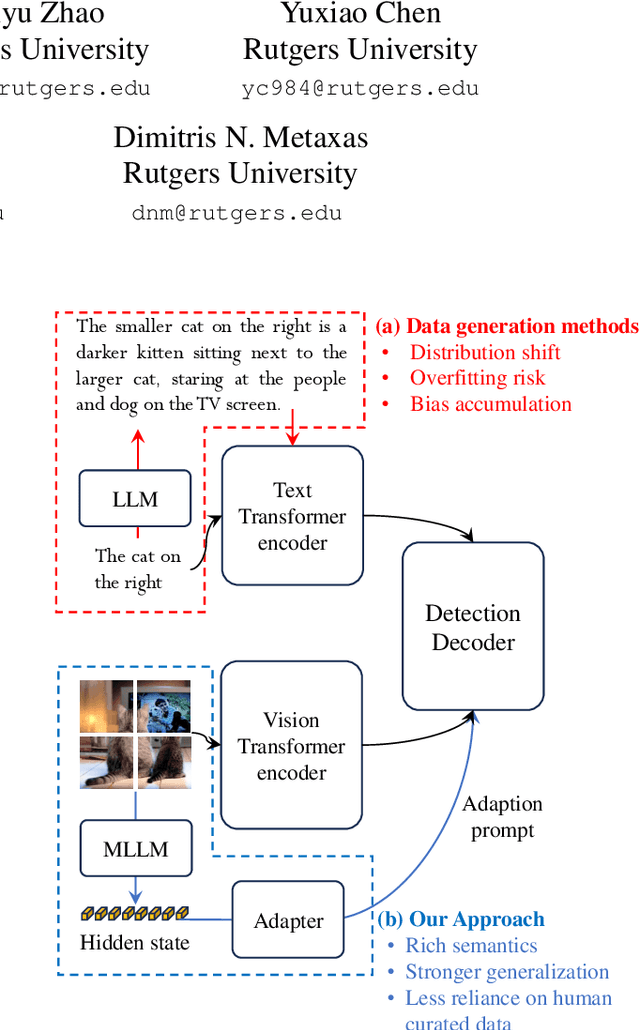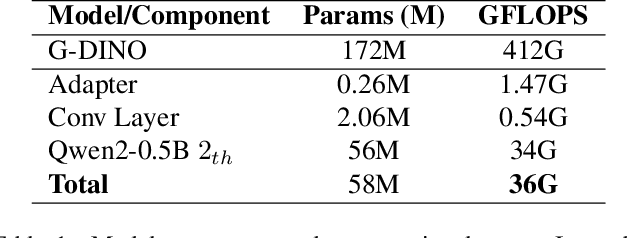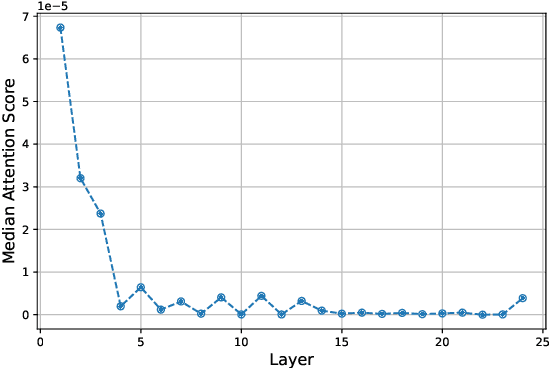Yuxiao Chen
RealDrive: Retrieval-Augmented Driving with Diffusion Models
May 30, 2025



Abstract:Learning-based planners generate natural human-like driving behaviors by learning to reason about nuanced interactions from data, overcoming the rigid behaviors that arise from rule-based planners. Nonetheless, data-driven approaches often struggle with rare, safety-critical scenarios and offer limited controllability over the generated trajectories. To address these challenges, we propose RealDrive, a Retrieval-Augmented Generation (RAG) framework that initializes a diffusion-based planning policy by retrieving the most relevant expert demonstrations from the training dataset. By interpolating between current observations and retrieved examples through a denoising process, our approach enables fine-grained control and safe behavior across diverse scenarios, leveraging the strong prior provided by the retrieved scenario. Another key insight we produce is that a task-relevant retrieval model trained with planning-based objectives results in superior planning performance in our framework compared to a task-agnostic retriever. Experimental results demonstrate improved generalization to long-tail events and enhanced trajectory diversity compared to standard learning-based planners -- we observe a 40% reduction in collision rate on the Waymo Open Motion dataset with RAG.
Deployable and Generalizable Motion Prediction: Taxonomy, Open Challenges and Future Directions
May 14, 2025Abstract:Motion prediction, the anticipation of future agent states or scene evolution, is rooted in human cognition, bridging perception and decision-making. It enables intelligent systems, such as robots and self-driving cars, to act safely in dynamic, human-involved environments, and informs broader time-series reasoning challenges. With advances in methods, representations, and datasets, the field has seen rapid progress, reflected in quickly evolving benchmark results. Yet, when state-of-the-art methods are deployed in the real world, they often struggle to generalize to open-world conditions and fall short of deployment standards. This reveals a gap between research benchmarks, which are often idealized or ill-posed, and real-world complexity. To address this gap, this survey revisits the generalization and deployability of motion prediction models, with an emphasis on the applications of robotics, autonomous driving, and human motion. We first offer a comprehensive taxonomy of motion prediction methods, covering representations, modeling strategies, application domains, and evaluation protocols. We then study two key challenges: (1) how to push motion prediction models to be deployable to realistic deployment standards, where motion prediction does not act in a vacuum, but functions as one module of closed-loop autonomy stacks - it takes input from the localization and perception, and informs downstream planning and control. 2) how to generalize motion prediction models from limited seen scenarios/datasets to the open-world settings. Throughout the paper, we highlight critical open challenges to guide future work, aiming to recalibrate the community's efforts, fostering progress that is not only measurable but also meaningful for real-world applications.
LED: LLM Enhanced Open-Vocabulary Object Detection without Human Curated Data Generation
Mar 18, 2025



Abstract:Large foundation models trained on large-scale visual-text data can significantly enhance Open Vocabulary Object Detection (OVD) through data generation. However, this may lead to biased synthetic data and overfitting to specific configurations. It can sidestep biases of manually curated data generation by directly leveraging hidden states of Large Language Models (LLMs), which is surprisingly rarely explored. This paper presents a systematic method to enhance visual grounding by utilizing decoder layers of the LLM of a MLLM. We introduce a zero-initialized cross-attention adapter to enable efficient knowledge transfer from LLMs to object detectors, an new approach called LED (LLM Enhanced Open-Vocabulary Object Detection). We demonstrate that intermediate hidden states from early LLM layers retain strong spatial-semantic correlations that are beneficial to grounding tasks. Experiments show that our adaptation strategy significantly enhances the performance on complex free-form text queries while remaining the same on plain categories. With our adaptation, Qwen2-0.5B with Swin-T as the vision encoder improves GroundingDINO by 2.33% on Omnilabel, at the overhead of 8.7% more GFLOPs. Qwen2-0.5B with a larger vision encoder can further boost the performance by 6.22%. We further validate our design by ablating on varied adapter architectures, sizes of LLMs, and which layers to add adaptation.
STRIDE: Automating Reward Design, Deep Reinforcement Learning Training and Feedback Optimization in Humanoid Robotics Locomotion
Feb 10, 2025



Abstract:Humanoid robotics presents significant challenges in artificial intelligence, requiring precise coordination and control of high-degree-of-freedom systems. Designing effective reward functions for deep reinforcement learning (DRL) in this domain remains a critical bottleneck, demanding extensive manual effort, domain expertise, and iterative refinement. To overcome these challenges, we introduce STRIDE, a novel framework built on agentic engineering to automate reward design, DRL training, and feedback optimization for humanoid robot locomotion tasks. By combining the structured principles of agentic engineering with large language models (LLMs) for code-writing, zero-shot generation, and in-context optimization, STRIDE generates, evaluates, and iteratively refines reward functions without relying on task-specific prompts or templates. Across diverse environments featuring humanoid robot morphologies, STRIDE outperforms the state-of-the-art reward design framework EUREKA, achieving significant improvements in efficiency and task performance. Using STRIDE-generated rewards, simulated humanoid robots achieve sprint-level locomotion across complex terrains, highlighting its ability to advance DRL workflows and humanoid robotics research.
The Hidden Life of Tokens: Reducing Hallucination of Large Vision-Language Models via Visual Information Steering
Feb 05, 2025



Abstract:Large Vision-Language Models (LVLMs) can reason effectively over both textual and visual inputs, but they tend to hallucinate syntactically coherent yet visually ungrounded contents. In this paper, we investigate the internal dynamics of hallucination by examining the tokens logits rankings throughout the generation process, revealing three key patterns in how LVLMs process information: (1) gradual visual information loss -- visually grounded tokens gradually become less favored throughout generation, and (2) early excitation -- semantically meaningful tokens achieve peak activation in the layers earlier than the final layer. (3) hidden genuine information -- visually grounded tokens though not being eventually decided still retain relatively high rankings at inference. Based on these insights, we propose VISTA (Visual Information Steering with Token-logit Augmentation), a training-free inference-time intervention framework that reduces hallucination while promoting genuine information. VISTA works by combining two complementary approaches: reinforcing visual information in activation space and leveraging early layer activations to promote semantically meaningful decoding. Compared to existing methods, VISTA requires no external supervision and is applicable to various decoding strategies. Extensive experiments show that VISTA on average reduces hallucination by abount 40% on evaluated open-ended generation task, and it consistently outperforms existing methods on four benchmarks across four architectures under three decoding strategies.
DreamDrive: Generative 4D Scene Modeling from Street View Images
Jan 03, 2025



Abstract:Synthesizing photo-realistic visual observations from an ego vehicle's driving trajectory is a critical step towards scalable training of self-driving models. Reconstruction-based methods create 3D scenes from driving logs and synthesize geometry-consistent driving videos through neural rendering, but their dependence on costly object annotations limits their ability to generalize to in-the-wild driving scenarios. On the other hand, generative models can synthesize action-conditioned driving videos in a more generalizable way but often struggle with maintaining 3D visual consistency. In this paper, we present DreamDrive, a 4D spatial-temporal scene generation approach that combines the merits of generation and reconstruction, to synthesize generalizable 4D driving scenes and dynamic driving videos with 3D consistency. Specifically, we leverage the generative power of video diffusion models to synthesize a sequence of visual references and further elevate them to 4D with a novel hybrid Gaussian representation. Given a driving trajectory, we then render 3D-consistent driving videos via Gaussian splatting. The use of generative priors allows our method to produce high-quality 4D scenes from in-the-wild driving data, while neural rendering ensures 3D-consistent video generation from the 4D scenes. Extensive experiments on nuScenes and street view images demonstrate that DreamDrive can generate controllable and generalizable 4D driving scenes, synthesize novel views of driving videos with high fidelity and 3D consistency, decompose static and dynamic elements in a self-supervised manner, and enhance perception and planning tasks for autonomous driving.
STORM: Spatio-Temporal Reconstruction Model for Large-Scale Outdoor Scenes
Dec 31, 2024



Abstract:We present STORM, a spatio-temporal reconstruction model designed for reconstructing dynamic outdoor scenes from sparse observations. Existing dynamic reconstruction methods often rely on per-scene optimization, dense observations across space and time, and strong motion supervision, resulting in lengthy optimization times, limited generalization to novel views or scenes, and degenerated quality caused by noisy pseudo-labels for dynamics. To address these challenges, STORM leverages a data-driven Transformer architecture that directly infers dynamic 3D scene representations--parameterized by 3D Gaussians and their velocities--in a single forward pass. Our key design is to aggregate 3D Gaussians from all frames using self-supervised scene flows, transforming them to the target timestep to enable complete (i.e., "amodal") reconstructions from arbitrary viewpoints at any moment in time. As an emergent property, STORM automatically captures dynamic instances and generates high-quality masks using only reconstruction losses. Extensive experiments on public datasets show that STORM achieves precise dynamic scene reconstruction, surpassing state-of-the-art per-scene optimization methods (+4.3 to 6.6 PSNR) and existing feed-forward approaches (+2.1 to 4.7 PSNR) in dynamic regions. STORM reconstructs large-scale outdoor scenes in 200ms, supports real-time rendering, and outperforms competitors in scene flow estimation, improving 3D EPE by 0.422m and Acc5 by 28.02%. Beyond reconstruction, we showcase four additional applications of our model, illustrating the potential of self-supervised learning for broader dynamic scene understanding.
Closed-Loop Supervised Fine-Tuning of Tokenized Traffic Models
Dec 05, 2024



Abstract:Traffic simulation aims to learn a policy for traffic agents that, when unrolled in closed-loop, faithfully recovers the joint distribution of trajectories observed in the real world. Inspired by large language models, tokenized multi-agent policies have recently become the state-of-the-art in traffic simulation. However, they are typically trained through open-loop behavior cloning, and thus suffer from covariate shift when executed in closed-loop during simulation. In this work, we present Closest Among Top-K (CAT-K) rollouts, a simple yet effective closed-loop fine-tuning strategy to mitigate covariate shift. CAT-K fine-tuning only requires existing trajectory data, without reinforcement learning or generative adversarial imitation. Concretely, CAT-K fine-tuning enables a small 7M-parameter tokenized traffic simulation policy to outperform a 102M-parameter model from the same model family, achieving the top spot on the Waymo Sim Agent Challenge leaderboard at the time of submission. The code is available at https://github.com/NVlabs/catk.
Exploiting VLM Localizability and Semantics for Open Vocabulary Action Detection
Nov 17, 2024



Abstract:Action detection aims to detect (recognize and localize) human actions spatially and temporally in videos. Existing approaches focus on the closed-set setting where an action detector is trained and tested on videos from a fixed set of action categories. However, this constrained setting is not viable in an open world where test videos inevitably come beyond the trained action categories. In this paper, we address the practical yet challenging Open-Vocabulary Action Detection (OVAD) problem. It aims to detect any action in test videos while training a model on a fixed set of action categories. To achieve such an open-vocabulary capability, we propose a novel method OpenMixer that exploits the inherent semantics and localizability of large vision-language models (VLM) within the family of query-based detection transformers (DETR). Specifically, the OpenMixer is developed by spatial and temporal OpenMixer blocks (S-OMB and T-OMB), and a dynamically fused alignment (DFA) module. The three components collectively enjoy the merits of strong generalization from pre-trained VLMs and end-to-end learning from DETR design. Moreover, we established OVAD benchmarks under various settings, and the experimental results show that the OpenMixer performs the best over baselines for detecting seen and unseen actions. We release the codes, models, and dataset splits at https://github.com/Cogito2012/OpenMixer.
Optimal Defenses Against Gradient Reconstruction Attacks
Nov 06, 2024



Abstract:Federated Learning (FL) is designed to prevent data leakage through collaborative model training without centralized data storage. However, it remains vulnerable to gradient reconstruction attacks that recover original training data from shared gradients. To optimize the trade-off between data leakage and utility loss, we first derive a theoretical lower bound of reconstruction error (among all attackers) for the two standard methods: adding noise, and gradient pruning. We then customize these two defenses to be parameter- and model-specific and achieve the optimal trade-off between our obtained reconstruction lower bound and model utility. Experimental results validate that our methods outperform Gradient Noise and Gradient Pruning by protecting the training data better while also achieving better utility.
 Add to Chrome
Add to Chrome Add to Firefox
Add to Firefox Add to Edge
Add to Edge